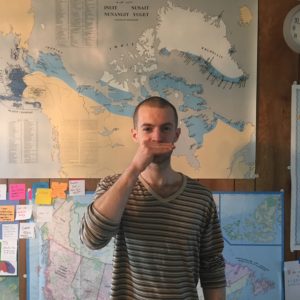The WAYK toolkit doesn’t provide a preset curriculum for any particular language; it provides the tools for generating this curriculum. In a sense, for us, “curriculum” has become somewhat of a dirty word, because of its conventional connotation as a prepared-materials-heavy, top-down, mostly static delivery of subject matter. But, we have to admit, the WAYK game doesn’t throw away the notion of a curriculum; in fact, it encourages the ongoing, ever-improving, generation of the best current approach for achieving fluent proficiency in any particular targeted skill. In a word, a “curriculum”…but an iterative one. To us, this makes all the difference – this goes to the heart of the “open source” nature of the game and mentoring language, that we call “Where Are Your Keys?”.
We’d like to provide a big picture of what this means.
Usually, we say that the heart of the game comes down to two core conversations: “WAYK” (the conversation about the pen, rock, stick, etc.), and “the WALK” (a moving, full-body conversation through an environment). Between the two of these, you learn the skill of “Language Hunting”, the ability to dynamically apply the mentoring language to the next bite-sized piece of fluent proficiency. Though you can rise to “Superior” level in just the “WAYK” conversation, it won’t teach you the whole breadth of the language. As you rise vertically, eventually you must begin a horizontal expansion too. And so we come, to the emerging cloud of “Same Conversations”.
The two core conversations have provided a learning laboratory, that you have returned to again and again, until you acquired the skills to “Set-up” a new “Same Conversation” that addresses the very next, most accessible cultural or skill-based area. We call this “Language Hunting” – the ability to begin to explore and test new possible “Same Conversations”, outside the safety of the core conversations that we provide as exemplars of the powerful application of the techniques. Those first two conversations role model what the next “Same Conversations” need to feel like, with all fundamental techniques firing at once and dovetailing together.
Let’s say you’ve decided to begin revitalizing your native language, we’ll call it “Native Language X”. You’ve spent hours gaining fluent proficiency in the core conversations, and now you have the skills to “Language Hunt” and “Set-up” a new “Same Conversation”.
Because of your particular culture, you know that harvesting/making tea, and canoeing, make the best next “Same Conversations” to “Set-up”.
By doing this, you’ve created two unique techniques, designed for your target language and culture; you’ll probably call them “Tea” and “Canoeing”. Let me repeat that; you’ve just begun developing your curriculum, for your unique language and culture. No one else in the world will have quite the same conversation as befits your language, environment, and culture. You’ve begun adding to the WAYK mentoring language, and have provided excellent examples of how others can do the same.
As you begin to “Set-up” these “Same Conversations”, you’ll realize that everyone who learns them will continue to improve them beyond what you can imagine (or control).Also, new possibilities for “Same Conversations” will continually emerge, as you perceive new important skills (and their attendant language and culture) and “Language Hunt” a “Set-up” for them. Perhaps “Hunting Deer“, “Salmon Feast”, and “Basketry” emerge as the next clearly needed conversations for your language/culture.
So, what about non-language applications? What about other targeted skills? Just to get you thinking out of the box, understanding how simply you can apply this approach, and in honor of our upcoming workshop hosted by members of the Agile software development community, we offer a “Same Conversation” cloud, with two possible next conversations.
“Stand-up meeting”, and “Pair programming”. Why choose these? We’ve chosen them almost at random, as possible starting points for the most-basic-conversations, but let’s go over some criteria for choosing and designing these “Same Conversations”. You want the next most basic conversations, that most commonly occur, that in all likelihood a newbie will run into immediately. You also want these conversations to hit at fundamental, need-based, and important skills. For revitalizing language, we choose skills that, though perhaps still basic, may still die out because of lack of use. We almost always start with food, and drink. For cultural and language revitalization, this (for many Pacific Northwest cultures) may mean a salmon bake. If we choose basketry next, we make the conversation start with the most common, and easiest baskets, hopefully used for collecting food, or some immediate, common need.
If you have the choice between two equally basic common conversations/situations/sub-skills, for revitalization choose the more endangered, and otherwise (say, for Agile) choose the one that hits the most of the target criteria: accessible, fundamental, common, need-based.
Think in a fluency order: what prior conversation does this particular skill/conversation require? Can you tease apart the dependencies?
By playing the core conversations “WAYK” and “the WALK”, you absorb the flow of the game, and the family of techniques (and therefore the mentoring language) into your body. You become fluent. All of this big-picture theorizing in some sense can distract from the actual process of “Language Hunting” and creating these conversations. Once you have “Obviously”, “Set-up“, “Contract”, “Travels with Charlie”, “Sorry, Charlie“, “Craig’s List”, “Lunatic Fringe”, “Bite-sized pieces”, “Fluent”, and so on, sunk into your bones, creating new “Same Conversations” will happen in accord with the game – one bite at at time, working each piece till fluent.
Keep in mind, that this process of expansion into the very next appropriate “Same Conversation” can theoretically go on forever. Do you know every “Same Conversation” in English? Every conversation a mystery novel writer would have with a peer; every conversation two civil engineers would have; two park rangers?
For this reason we prioritize them according to our purposes; we “Limit” our “Same Conversation” by ranking them in order of the most fundamental, need-based conversations required to spread out to the very next one. In language revitalization we can also rank according to endangerment of the “Same Conversation” (basketry, medicine, storytelling, etc.). We definitely want to revitalize the skills we can, while we still have fluent practitioners! But otherwise, stick to the fluency ranking; one “Same Conversation” at a time, each conversation in its turn, building on the one before (and preparing for the next).











This is the second time you’ve mentioned “The Walk,” and I think the first time you’ve defined it in any way.
Do I understand the technique to build on the basic WAYK conversation in the core curriculum, with the addition of moving around in the environment and building both new nouns (“What is that?”) as well as discovering news way to apply the vocabulary learned from a table-based session of WAYK?
I’d love you to elaborate on “The Walk” some more.
Alan-
Thanks for your question. You’re essentially correct, and “the Walk” also adds in a few other things natural to the conversation of “going for a walk”, like commands and so on. It’s essentially just a second exemplar of how “Same Conversation” changes naturally according to the “Set up” environment.
That cuts to the essential thing we wish to communicate; not the idea of “secret techniques” that we dole out one by one, but that a truly fundamental understanding of the core techniques like “obviously” will generate the entire “WAYK” curriculum. But you can only achieve this fundamental fluency through lots and lots of play and reflection on play (and having us visit doesn’t hurt either).
I’ll definitely post more on this as soon as I can. However, you simply can’t lose mastering the core WAYK conversation, and adding to it bit by bit, so we haven’t rushed adding “the Walk” on to the website.
One bite at a time, to fluency!
I’ve been wondering, how does one work the written language into the process?
What I picture is, once everyone is familiar with the spoken version of a given conversation, then the next phase is to speak each part and write it down. That is, the participant would sign “What is that?” while saying it in the target language; then that same person writes down “What is that?” in the language. The responder would sign and say “That is a stick” then write down “That is a stick”. And so on.
Or is there a smoother way to build on written fluency?
Joshua-
Fantastic questions. Thanks for asking.
The easiest way to address the transition from oral to written?
Read the Universal Speed Curriculum version of your conversation.
Once you’ve had the conversation, gained fluency in it, and only then you look at the written version of it, it becomes extremely easy to rapidly acquire reading and writing comprehension in those conversations. You know exactly what you’ve said; you know the sounds you’ve made; reading the written conversations acts as a kind of rosetta stone [no relation to the company by that same name, or its products] for understanding the written orthography of your target language.
I highly recommend running this experiment. Get your fluent fool to transcribe your target language’s “WAYK?” conversation in a Universal Speed Curriculum style. Play the conversation with them till you feel very fluent. Then read the transcription. It’s a pretty cool effect. 🙂 Your brain will probably explode a little bit. In a good way. This is more marked with alphabets similar to your own, of course (roman alphabets for English speakers, etc.), but it nevertheless accelerates your progress for reading comprehension in any language.
Yes a great question indeed !!!
My advice… SPEAK, SPEAK, SPEAK.
I never “teach” people how to read or write. I always focus on speaking. During play of the game, and in all the play of developing new “same conversations”, I call technique “Sorry, Charlie” when students try to take notes or write things down. If you don’t already know, when playing WAYK we call “Sorry, Charlie” when another player attempts to go over another player’s fluency (in this case, a player is doing it to themself by trying to jump forward to written fluency before they’ve achieved oral fluency). Just to be clear: Expect to play the first WAYK “same conversation” several times before “writing” should even be on your mind.
These techniques (such as “Sorry, Charlie”) are all about speed. What is the fastest way to learn to read? Learn to speak! If you have the “same conversation” over and over again you will soon be able to have a simple “fluent” conversation in the target language. Hasn’t your goal of speaking a language already come to pass?
Here’s some specific tips:
1. When you can play WAYK (the pen/stick/rock/etc. conversation) to some fluency record a session of that same conversation on audio and or video. Send us a copy 🙂
2. Now get your fluent fool to write out this recorded conversation for you in the script of the language. Use two different colors of ink to show who is talking. Please use red and black. fluent fool should be written in black and the new learner written in red.
3. Now listen to the recording/watch the video and “read” the script. You will be AMAZED at your new ability to “read” and “write” in the language. Now record another session of that “same conversation”. Remember, you will never have the exact same conversation twice. Try to have the same conversation but accept and enjoy the fact that they will not be exactly the same.
4. Now try your hand at writing the conversation out. Show your work to your fluent fool… Now you are learning to read and write. but you have learned to SPEAK first.
Repeat.
Enjoy.
[…] room, but walking down a street, driving, working at a desk in front of a window, etc.).[aka the WAYK “Same Conversation”, for you smarty pants out […]